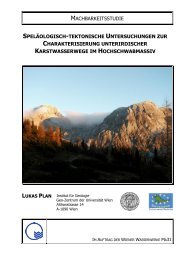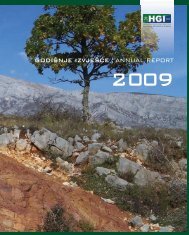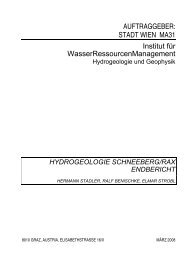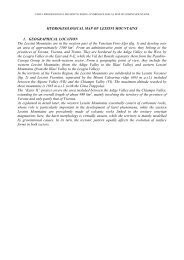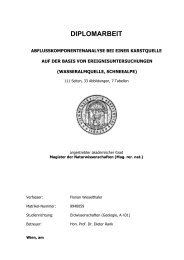Explanatory notes to the digital geological map of the Rax ... - KATER
Explanatory notes to the digital geological map of the Rax ... - KATER
Explanatory notes to the digital geological map of the Rax ... - KATER
You also want an ePaper? Increase the reach of your titles
YUMPU automatically turns print PDFs into web optimized ePapers that Google loves.
<strong>KATER</strong> II Geology <strong>of</strong> <strong>the</strong> <strong>Rax</strong>-Schneeberg-region<br />
__________________________________________________________________________________________<br />
Abstract<br />
Within <strong>the</strong> karst water system <strong>the</strong> <strong>geological</strong> setting is responsible for <strong>the</strong> collection, filtering,<br />
s<strong>to</strong>rage and distribution <strong>of</strong> karst water on its way down from <strong>the</strong> surface through permeable<br />
rocks <strong>to</strong> <strong>the</strong> spring. The <strong>geological</strong> setting provides boundary conditions <strong>to</strong> apply general<br />
models on specific aquifers as well as <strong>to</strong> interpret measurements <strong>of</strong> water parameters (e.g.<br />
discharge curves, water chemistry, iso<strong>to</strong>pes and o<strong>the</strong>rs).<br />
Due <strong>to</strong> <strong>the</strong> complex <strong>geological</strong> genesis <strong>of</strong> <strong>the</strong> project area <strong>the</strong> <strong>geological</strong> <strong>map</strong>ping had <strong>to</strong> be<br />
accompanied by additional investigations in lithostratigraphy, biostratigraphy, micropalaen<strong>to</strong>logy,<br />
carbonate facies (lateral transitions) and tec<strong>to</strong>nics.<br />
Mesozoic carbonates are <strong>the</strong> dominant rock type within <strong>the</strong> Nor<strong>the</strong>rn Calcareous Alps,<br />
whereas siliciclastic sediments are restricted <strong>to</strong> a few stratigraphic levels and act as layers <strong>of</strong><br />
reduced permeability. The following sedimentary succession forms <strong>the</strong> Schneeberg/<strong>Rax</strong> area<br />
(<strong>the</strong> mentioned thicknesses may vary considerable due <strong>to</strong> tec<strong>to</strong>nic cutting):<br />
The sedimentary succession starts with Permian continental red beds (Prebichl-Fm.; 0-150<br />
meters), transgressing discordant over Early Paleozoic rocks <strong>of</strong> <strong>the</strong> Greywacke Zone. A<br />
marine clay-evaporite association is locally developed and may affect <strong>the</strong> water quality with<br />
sulfates. The Early Triassic is characterized by deposition <strong>of</strong> some 100 meters <strong>of</strong> marine<br />
shallow shelf siliciclastics (Werfen-Fm.). They represent <strong>the</strong> main layer <strong>of</strong> low permeability.<br />
In Middle Triassic times carbonate sedimentation became prevailing with well bedded<br />
(Gutenstein-Formation; 150 m) and massive limes<strong>to</strong>nes and dolomites (Steinalm-Formation;<br />
80-100 m). During <strong>the</strong> Middle Anisian a rapid deepening <strong>of</strong> <strong>the</strong> marin environment was<br />
associated with blockfaulting. This has generated a pronounced relief <strong>of</strong> <strong>the</strong> sea-floor, which<br />
is <strong>the</strong> reason for <strong>the</strong> subsequent development <strong>of</strong> different sedimentary facies: shallow-water<br />
carbonate platforms (Wetterstein-Formation and lateral slope sediments) coexist with basins<br />
<strong>of</strong> different shape, water depth and circulation. Four types <strong>of</strong> basinal sediments occur in <strong>the</strong><br />
investigated area: black, thin bedded allodapic limes<strong>to</strong>nes (Grafensteig-Fm., 300 m), nodular<br />
limes<strong>to</strong>nes with chert (Reifling-Fm.; 20-30 m), light grey <strong>to</strong> reddish, nodular, bedded or<br />
massive limes<strong>to</strong>nes (Hallstatt Limes<strong>to</strong>nes; 40 m) and bedded <strong>to</strong> massive multicolored<br />
allodapic limes<strong>to</strong>nes (up <strong>to</strong> 250 m).<br />
In general, <strong>the</strong> Wetterstein platforms show a rapid progradation <strong>of</strong> reef and reef breccias<br />
over <strong>the</strong> adjacent basinal sediments. The thick platform carbonates (up <strong>to</strong> 1000 m) build <strong>the</strong><br />
main aquifer in <strong>the</strong> Hochschwab and Schneeberg/<strong>Rax</strong> region. The primary porosity <strong>of</strong> <strong>the</strong>se<br />
bioclastic sediments has been lost due <strong>to</strong> early diagenetic cementation. During diagenesis<br />
also parts <strong>of</strong> <strong>the</strong> Wetterstein limes<strong>to</strong>ne as well as parts <strong>of</strong> <strong>the</strong> adjacent basinal limes<strong>to</strong>nes<br />
became transformed in<strong>to</strong> dolomite. Extended bodies <strong>of</strong> dolomitic rocks within <strong>the</strong> aquifer are<br />
responsible for lower percolation rates and a more regular discharge <strong>of</strong> some springs.<br />
The prevailing carbonate producing organisms within <strong>the</strong> platform lagoon were calcareous<br />
green algae (dasycladaceans). The knowledge about <strong>the</strong>ir distinct evolution during Triassic<br />
Times has been proved recently by correlation with conodont zonation and can be used now<br />
as a powerfull <strong>to</strong>ol for biostratigraphic dating. Tec<strong>to</strong>nic <strong>of</strong>fset along fault zones within<br />
mono<strong>to</strong>nous platform carbonates could be recognized and sometimes quantified in this way.<br />
In <strong>the</strong> early Upper Triassic (Carnian) <strong>the</strong> platforms emerged and <strong>the</strong> basins received<br />
sands<strong>to</strong>nes and shales (10-30 m). In <strong>the</strong> Late Carnian a sea-level rise has initiated <strong>the</strong><br />
development <strong>of</strong> <strong>the</strong> Norian carbonate platform (up <strong>to</strong> 1000m) characterized by Dachstein<br />
limes<strong>to</strong>ne (reef and lagoonal facies) and Hauptdolomite (intertidal facies).<br />
Most <strong>of</strong> <strong>the</strong> following younger rocks are <strong>of</strong> minor significance for <strong>the</strong> lithological composition<br />
<strong>of</strong> <strong>the</strong> karst aquifer but relevant for revealing <strong>the</strong> structural his<strong>to</strong>ry.<br />
3



